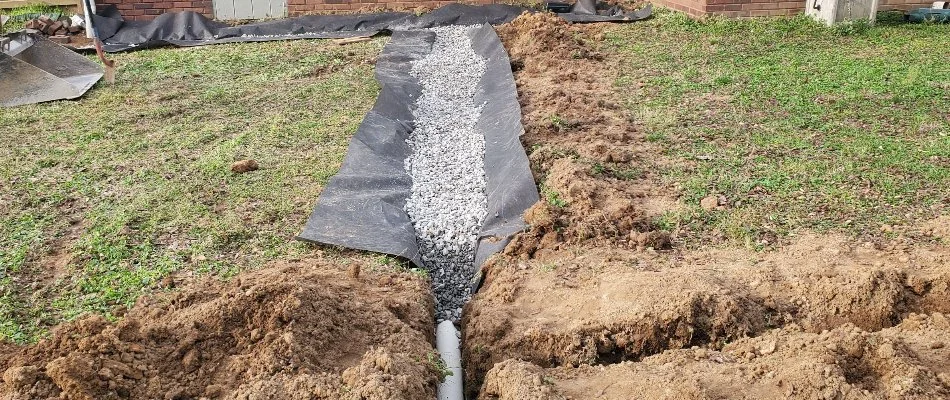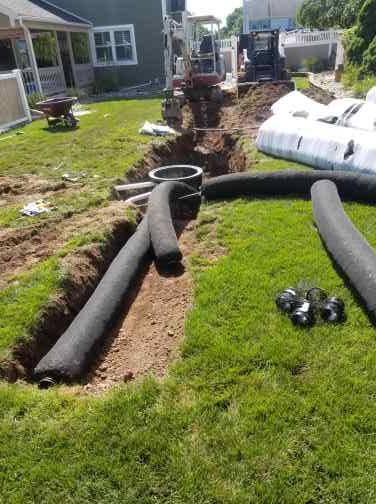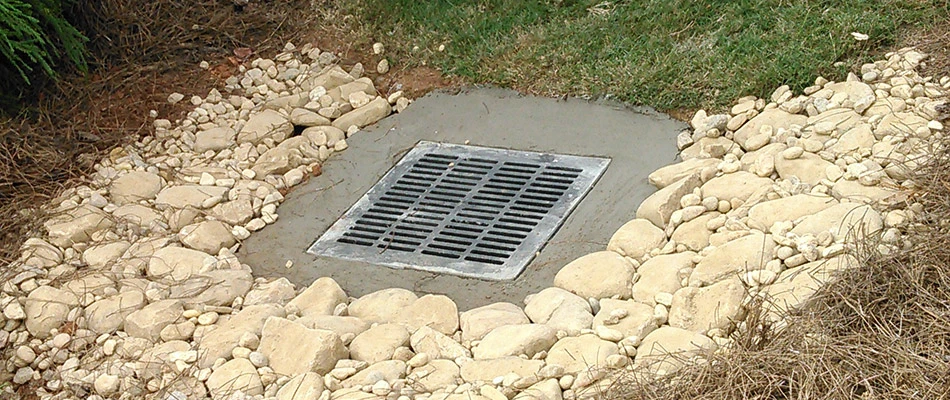Are you frustrated with pooling water in your yard every time it rains? You’re not alone.
Many homeowners face the challenge of managing excess water effectively. The good news is that you have options to tackle this issue head-on. Two popular solutions are the dry creek bed and the French drain. But which one is right for your property?
Choosing the wrong method can lead to wasted time, effort, and money. Imagine the peace of mind knowing your yard is protected from water damage, and your landscaping remains pristine. We’ll break down the differences between a dry creek bed and a French drain, helping you make an informed decision. Keep reading to discover the advantages of each and find out which solution best fits your needs.

Credit: www.fivestarlawnandlandscaping.com
Dry Creek Bed Basics
Dry creek beds provide a natural way to manage water flow. They mimic the appearance of a natural stream. This makes them a popular choice for landscaping. They are functional and add beauty to outdoor spaces.
Purpose And Function
Dry creek beds help control water drainage. They prevent erosion and manage runoff. These beds direct water flow safely away from areas that might flood. They work well in areas with heavy rain or poor drainage.
Design And Aesthetics
Dry creek beds enhance the look of a garden. They can be designed to look like real creeks. Use stones and plants to mimic nature. Their design can be simple or complex. They add visual interest to any landscape. They can become a beautiful focal point in a yard.
French Drain Fundamentals
French drains are a practical solution for managing water around your home. They redirect water away from areas where it collects. This system helps prevent water damage and keeps your landscape dry.
How It Works
A French drain collects and channels water using a trench. The trench contains a perforated pipe. Water enters the pipe through these holes and flows away from the problem area. Gravel surrounds the pipe to filter debris.
Installation Process
To install a French drain, first, dig a trench. The trench should slope away from the house. This slope ensures water flows naturally. Next, lay a layer of gravel at the bottom. Then, place the perforated pipe on top of the gravel.
Cover the pipe with more gravel. This helps keep debris out. Finally, add a layer of fabric or soil over the gravel. This completes the installation, ensuring the drain functions properly.
Comparing Effectiveness
Choosing between a Dry Creek Bed and a French Drain requires careful consideration. Each method has distinct strengths. These methods handle water differently, impacting your landscape effectively.
Water Handling Capacity
A Dry Creek Bed mimics a natural stream. It directs water across the landscape visually. This approach suits areas with occasional heavy rainfall. It handles larger water volumes temporarily. The French Drain channels water underground efficiently. It consists of a gravel-filled trench with a pipe. The pipe collects and redirects water away. Ideal for consistently wet areas. It manages water year-round without surface disruption.
Long-term Maintenance
Dry Creek Beds require minimal upkeep. Periodic debris removal is necessary. Ensuring clear pathways for water flow is crucial. Rocks may need repositioning occasionally. French Drains need regular checks. The pipe can clog with sediment over time. Cleaning or flushing ensures optimal performance. Routine inspections prevent drainage issues.

Credit: www.whitehouselandscaping.com
Cost Considerations
When considering drainage solutions for your property, cost is a significant factor. The choice between a dry creek bed and a French drain can impact your budget in different ways. Understanding the cost considerations will help you make an informed decision that suits your needs and financial plan.
Material Costs
Material costs can vary greatly between a dry creek bed and a French drain. A dry creek bed typically requires stones of varying sizes, which can be sourced locally to keep expenses down. If you have access to a nearby quarry, you might find stones at a reduced rate or even free.
On the other hand, French drains require specialized materials like perforated pipes, gravel, and fabric liners. These components can add up quickly, especially if your project covers a large area. Compare prices at local hardware stores and online to find the best deals.
Labor And Installation
Labor and installation can be the most significant expense in either project. Building a dry creek bed can be a DIY project if you have the time and physical ability. However, hiring professionals might be necessary if you’re dealing with challenging terrain.
French drains, due to their complexity, often require professional installation. This increases labor costs, as specialized skills and equipment are needed to ensure proper functionality. Consider the long-term savings of a properly installed system against the initial labor cost.
Have you considered the time and effort you’re willing to invest? Balancing DIY potential against professional help can guide your decision. Sometimes, spending a little more upfront saves you headaches down the road.
Environmental Impact
Comparing the environmental impact, dry creek beds offer a natural look, blending seamlessly into landscapes. French drains, while effective for water management, require more materials and can alter soil ecosystems. Both methods serve specific purposes, but their ecological footprints differ.
Choosing wisely helps maintain ecological balance.
When considering drainage solutions like a Dry Creek Bed or a French Drain, understanding their environmental impact is crucial. Each option has unique benefits and influences on the ecosystem and your landscape. Let’s explore how they differ in terms of eco-friendliness and their impact on the surrounding landscape.Eco-friendliness
A dry creek bed can be a more natural choice for environmentally conscious homeowners. It mimics the natural flow of water, promoting groundwater recharge and reducing runoff. This can help maintain local water tables and support plant life. French drains, while effective, often involve synthetic materials like perforated pipes and gravel. These materials can sometimes disrupt the soil structure and may not be as biodegradable. Consider if the short-term drainage benefits outweigh the long-term environmental costs. Do you prioritize sustainability in your home projects? Opting for a dry creek bed might align better with your green goals. It can enhance biodiversity, offering habitats for native plants and insects.Impact On Surrounding Landscape
A dry creek bed can transform a bland yard into a picturesque landscape feature. It can guide rainwater smoothly, reducing erosion and protecting your garden. Its natural appearance blends seamlessly with existing greenery. On the other hand, a French drain is often less visible, tucked below ground. While it efficiently redirects water, it can sometimes necessitate more significant landscape alterations. Think about how much you value aesthetic appeal versus functionality. Consider how each option will adapt over time. A dry creek bed may evolve naturally, becoming a dynamic part of your garden ecosystem. However, French drains require regular maintenance to ensure they function properly. Which is more important to you: a visually pleasing landscape or hidden efficiency? Your answer could sway your choice between these two drainage solutions.Best Situations For Each Option
Choosing between a dry creek bed and a French drain can be tricky. Both options manage water effectively. But they serve different purposes. Understanding the best situations for each helps make the right choice.
Ideal Conditions For Dry Creek Beds
Dry creek beds work well in areas with natural slopes. They guide water naturally. If you face occasional heavy rain, they are a good choice. They fit well into landscapes with rocks and plants. They also add beauty to gardens and yards. Dry creek beds handle water overflow efficiently. They prevent erosion and soil loss.
Optimal Scenarios For French Drains
French drains suit flat areas with poor drainage. They are great for basements prone to water issues. If water pools around your foundation, consider a French drain. They work beneath driveways and walkways too. French drains redirect water away from structures. They prevent flooding and water damage.
Expert Recommendations
Choosing between a dry creek bed and a French drain depends on your landscape needs. A dry creek bed enhances garden aesthetics while managing water flow. French drains efficiently channel water away from structures, preventing foundation issues. Both solutions offer unique benefits, tailored to specific drainage challenges.
When deciding between a dry creek bed and a French drain for your landscape, expert recommendations can guide you to make the best choice. Both options have their merits, but understanding the nuances can save you from future headaches. Let’s dive into what professionals suggest and some common pitfalls you should steer clear of.Professional Insights
Experts often recommend dry creek beds for their aesthetic appeal and natural integration into landscapes. They are particularly suited for areas with heavy rainfall where you want to manage runoff attractively. French drains, on the other hand, are highly effective for redirecting water away from foundations, crucial in preventing water damage. Your choice might depend on your landscape goals. Are you aiming for visual appeal or practical water management? A landscape architect I once worked with emphasized that a dry creek bed could serve as a garden feature, while a French drain could remain hidden yet functional.Common Mistakes To Avoid
One frequent error is neglecting proper slope and grading, especially for French drains. Without the right slope, water won’t flow efficiently, rendering the system ineffective. Ensure your drain has at least a 1% slope for optimal performance. Another mistake is underestimating the size of the area needing drainage. Installing a dry creek bed that’s too small can lead to overflow and erosion issues. Ask yourself if you’ve accurately assessed the water volume your landscape typically encounters. Using improper materials can also lead to failure. Selecting the wrong type of gravel or not using a fabric liner in your French drain can lead to clogs and reduced efficiency. Are you using the materials best suited for your soil and water conditions? Lastly, skipping regular maintenance can turn both systems into liabilities. A clogged French drain or debris-filled creek bed won’t serve its purpose. Are you ready to commit to periodic checks and cleaning?
Credit: bloomngardens.com
Frequently Asked Questions
What Is A Dry Creek Bed?
A dry creek bed is a shallow trench filled with rocks. It directs water away from areas.
How Does A French Drain Work?
A French drain uses a perforated pipe to redirect water. It prevents water buildup in your yard.
Which Is More Cost-effective: Dry Creek Bed Or French Drain?
Dry creek beds generally cost less. French drains can be more expensive due to installation needs.
Can Dry Creek Beds Prevent Flooding?
Yes, they can help manage surface water. But they may not stop heavy flooding alone.
Do French Drains Need Regular Maintenance?
Yes, they require occasional checks. Ensure the pipe is not clogged for efficient drainage.
Conclusion
Choosing between a dry creek bed and French drain depends on your needs. Dry creek beds add beauty and control water flow. French drains efficiently redirect water away from structures. Consider your landscape and drainage issues. Dry creek beds suit decorative purposes.
French drains excel in practical water management. Both have unique benefits. Assess your yard’s specific requirements. Analyze aesthetics, functionality, and budget. Make an informed choice for your space. Proper drainage protects property and enhances outdoor areas. Balance form and function for the best outcome.
Choose wisely for a harmonious landscape.




